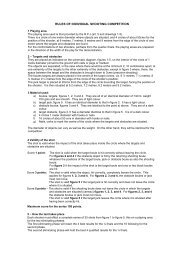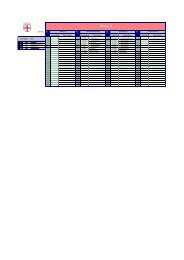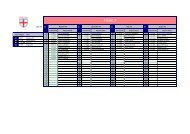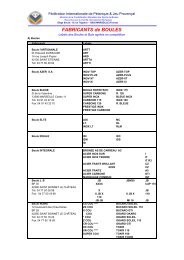Design of the Playing Area - English Petanque Association
Design of the Playing Area - English Petanque Association
Design of the Playing Area - English Petanque Association
Create successful ePaper yourself
Turn your PDF publications into a flip-book with our unique Google optimized e-Paper software.
Section Four<br />
THE DESIGN OF A PLAYING AREA<br />
_________________________________<br />
1. <strong>Design</strong>ing a Pétanque terrain<br />
Preparing a terrain for pétanque does not require a high initial outlay and maintenance is<br />
minimal once it is established. Many establishments find that <strong>the</strong>y already have a suitable<br />
surface available and <strong>of</strong>ten it is not necessary to make any special effort to put down a pétanque<br />
terrain. Several clubs flourish on existing car parks or gravel drives.<br />
What is required for a good terrain is a well-drained base on which has been spread a quite thin<br />
layer <strong>of</strong> small loose material. The area required for each game is called a lane. For International<br />
competition and National Championships <strong>the</strong> minimum dimensions for a single lane is 15m x<br />
4m with a fur<strong>the</strong>r metre outside this area before any solid barriers (see diagram below), so for<br />
one full size lane you will need an area 17m x 6m. However <strong>the</strong>se dimensions are frequently<br />
altered for club and leisure situations to take account <strong>of</strong> limited space available. Many club<br />
terrains are built to have 12m x 3m lanes<br />
2. A <strong>Playing</strong> Lane<br />
There is no exact laid down specification for a lane, except in size(see Figure 1for a full size International<br />
lane ). As a basic rule it must not be so flat that a boule can be rolled dead straight on it, nei<strong>the</strong>r should <strong>the</strong><br />
top dressing be so thick that it allows little or no forward movement <strong>of</strong> a boule once it lands. All-wea<strong>the</strong>r<br />
pitches can be used for pétanque but, if <strong>the</strong>y are too smooth, <strong>the</strong>y severely restrict <strong>the</strong> range <strong>of</strong> shots that<br />
can be used and take out <strong>the</strong> element <strong>of</strong> chance which attracts beginners. Experienced players do not like<br />
<strong>the</strong>m, as a part <strong>of</strong> <strong>the</strong> real skill <strong>of</strong> <strong>the</strong> game is “reading” <strong>the</strong> surface. A good player will use <strong>the</strong> undulations<br />
<strong>of</strong> a lane when deciding <strong>the</strong> line to be taken to <strong>the</strong> jack.<br />
Pétanque may be played on any surface but grass is not recommended, gravel or hard earth are <strong>the</strong><br />
favoured surfaces. In <strong>the</strong> UK we try to recreate <strong>the</strong> dusty squares and areas where pétanque is played in<br />
France, however we tend to have a wetter climate so it is for this reason we construct areas similar to<br />
gravel driveways so we can play when <strong>the</strong> wea<strong>the</strong>r is inclement.
3. Sub-base<br />
The worst case scenario is shown in Figure 2. This is only necessary on land where drainage is<br />
very poor. Drainage stones, in particular, are only really required if <strong>the</strong> land is likely to become<br />
waterlogged. Therefore, depending on <strong>the</strong> type <strong>of</strong> site <strong>the</strong> terrain is to be constructed upon, it may<br />
be possible, if it is sufficiently well drained, to dispense with <strong>the</strong> preparation <strong>of</strong> <strong>the</strong> lower two levels,<br />
ie. <strong>the</strong> large stones and hardcore. A local builder will be able to advise on <strong>the</strong> structure <strong>of</strong> local<br />
ground conditions. It is, however, very important if <strong>the</strong> terrain is to be well laid and long lasting, for<br />
<strong>the</strong> organic topsoil to be removed to at least a depth <strong>of</strong> 25cm. before <strong>the</strong> scalpings or hogging that<br />
are to form <strong>the</strong> base <strong>of</strong> <strong>the</strong> terrain are laid down. If <strong>the</strong> land is not well drained (eg. clay) and<br />
hardcore and drainage stones are being used it is advised to increase <strong>the</strong> depth <strong>of</strong> <strong>the</strong> whole subbase<br />
to at least 40cm. A good base could be made <strong>of</strong> 3.5cm. crushed quarry stone, this is known<br />
by Builders’ Merchants as No.1 sub base or scalpings. A heavy roller or vibrating compactor over<br />
this provide a hard firm surface. However, if played on at this stage <strong>the</strong> larger stones may well<br />
come to <strong>the</strong> surface. The area will need subsequent rolling and watering to settle <strong>the</strong> stones down.<br />
4. Top Dressing<br />
Once <strong>the</strong> area has been very well compacted a thin layer <strong>of</strong> granite dust (4mm to dust) should be<br />
spread over <strong>the</strong> area and rolled. The point about top dressing is that it should be just deep enough<br />
to provide <strong>the</strong> boule with some grip on landing, but not so deep that <strong>the</strong> boule sinks into it to any<br />
extent. When <strong>the</strong> top surface is too deep it is impossible to play <strong>the</strong> game properly. The ideal top<br />
dressing depth is about 6mm.<br />
5. Surround<br />
When completed, a terrain will need a protective surround <strong>of</strong> some sort. This usually made <strong>of</strong> wood<br />
as this material best absorbs <strong>the</strong> impact <strong>of</strong> <strong>the</strong> boules. A good way <strong>of</strong> providing this very necessary<br />
protection for spectators is to put railway sleepers, old telegraph poles or scaffold boards around<br />
<strong>the</strong> terrain, ensuring that <strong>the</strong>y are well fixed as a boule can hit <strong>the</strong>m with considerable force. The<br />
terrain border should be at least 23cm. to 30cm. high. It is a good idea to leave a space for entry<br />
on to <strong>the</strong> terrain and to provide a ramp to assist disabled players to gain easy access.<br />
6. Drainage<br />
Water escape routes can be constructed by <strong>the</strong> following methods, if necessary:<br />
a. Land Drainage pipe<br />
Dig a trench deep enough to create a fall from <strong>the</strong> terrain to <strong>the</strong> outlet. Lay in drainage<br />
pipes, cover with pea-gravel and back fill with top soil.<br />
b. Common Soak-away<br />
Carry out as for land drain. At <strong>the</strong> outlet dig a hole 1.5m. deep by 1m. square. Fill with<br />
hardcore (broken bricks etc.) Cover with a plastic sheet or cap with a concrete finish about<br />
30cm. below <strong>the</strong> surface. Back fill with top soil.<br />
c. French Drain<br />
About 1m. from <strong>the</strong> outside <strong>of</strong> <strong>the</strong> terrain area that floods, did a trench. Fill with<br />
16mm/25mm. pebbles up to <strong>the</strong> surface. This will act as a soak-away and a walk area.<br />
7. Size<br />
If more than one game at a time is envisaged, <strong>the</strong> overall size <strong>of</strong> <strong>the</strong> terrain, ie. <strong>the</strong> total number<br />
<strong>of</strong> individual lanes, must be decided. Each lane will cater for up to six people, as <strong>the</strong> most<br />
common game is triples. A game <strong>of</strong> Pétanque can be played, as stated before, on lanes <strong>of</strong> 3m. x<br />
12m. or, ideally, 4m. x 15m.plus allowance should be made before any protective surround is<br />
erected.









